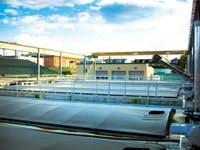Long considered the best available technology, membrane bioreactors (MBR) have historically been more expensive and energy-intensive than conventional wastewater treatment technologies. Improved approaches to MBR system design and operation, however, have negated these issues and leveled the playing field.
The challenge now is to utilize better evaluation methods and to properly incentivize energy-efficient operations to make the best available technology more accessible to more projects.
Perusing the literature or surfing the Internet, one can easily find comments like the following regarding MBR costs:
- • “MBR equipment costs have come down from $3.00/gal to $0.75/gal.”
- • “MBR prices have dropped eightfold over the last decade.”
These kinds of statements reflect improved manufacturing, delivery and design practices of membrane equipment (the commodity) but do not address perhaps a more important trend: a growing body of information suggesting that MBR system designs have dramatically improved over the past decade to bring down the total cost of ownership as compared with conventional activated sludge (CAS), sequencing batch reactors (SBR), moving-bed bioreactors and vertical loop reactors. In fact, in a recent survey of five engineering evaluations, MBR systems fared well against older technologies in terms of capital cost and net present worth.
The summary presented here includes the results from five completely separate analyses conducted by five different engineers, for different clients on unrelated projects. Some of the cost categories evaluated, and the related savings, are listed below:
- • Solids handling (less than 40% cost savings);
- • Concrete/buildings (50% to 80% cost savings);
- • Equalization (greater than 50% savings compared with SBR); and
- • Constructability/phasing (greater than 50% savings due to less site work).
In addition to these bigger-ticket items, remote monitoring capabilities, pending nutrient limits and projected growth are examples of non-cost factors that routinely favored the selection of MBRs.
From the Arlington wastewater treatment plant in Washington, D.C., to the Upper Wallkill plant in New Jersey, across the country, in different applications, at a variety of flows, the trend toward MBR systems is clear. But there is still one question hindering the unfettered use of MBRs anywhere and everywhere: “Is MBR technology too energy-intensive?” The answer is: “It should not be.”
In a recent survey of 13 full-scale MBR plants, actual energy bills were normalized and averaged over time (one to five years). As a whole, two surprising trends emerged from the study:
- 1. Plant (total) energy bills did not correlate to purported membrane efficiency. In other words, plants using membrane technology that required less air scouring actually consumed significantly more energy as a whole.
- 2. Plants operated by an incentivized party (the supplier, in reported cases) performed better than those that were not. In fact, actual energy consumption data for MBR systems operated by the suppliers, which was responsible for total energy, performed about the same as comparable CAS plants (~3,000 kWh per million gallons of wastewater).
Extracting specific conclusions from such aggregate data can prove challenging, if not academic, given all of the variables involved. The trends appear to hold up under a microscope, however, and point to solutions that go beyond more efficient membranes.
MBR technology is a viable, affordable wastewater treatment technology if properly designed and operated. While important innovations are being made at the commodity level, system improvements have made the best available technology competitive with conventional technologies in terms of total cost of ownership. It is up to industry professionals to properly evaluate MBR systems and incentivize energy-efficient operations.
Download: Here



